Analysis of Dry-Wet Changes and the Driving Factors in Mainland China under Climate Change
Abstract
:1. Introduction
2. Data and Method
2.1. Study Area
2.2. Data Collection
2.3. Calculation of the Aridity Index and ET0
2.4. Trend Analysis
2.5. Sensitivity and Contributors
3. Results
3.1. Trends in Regional Wet-Dry Climate
3.1.1. Trends in the Aridity Index
3.1.2. Trends in Annual Precipitation and ET0
3.2. The Driving Factors of ET0 Change
3.2.1. The Sensitivity Coefficients of Four Climate Variables
3.2.2. The Long-Term Changes in Four Climate Variables
3.2.3. Contributions of Climate Variables to Changes in ET0
4. Discussion
5. Conclusions
Author Contributions
Funding
Data Availability Statement
Acknowledgments
Conflicts of Interest
References
- IPCC. Climate Change 2021: The Physical Science Basis; Cambridge University Press: Cambridge, UK, 2021. [Google Scholar]
- Shen, S.H.; Zhang, F.M.; Sheng, Q. Spatio-temporal changes of wetness index in China from 1975 to 2004. Trans. CSAE 2009, 25, 11–15, (In Chinese with English Abstract). [Google Scholar] [CrossRef]
- Hernandez, E.A.; Uddameri, V. Standardized precipitation evaporation index (SPEI)-based drought assessment in semi-arid south Texas. Environ. Earth Sci. 2013, 71, 2491–2501. [Google Scholar] [CrossRef]
- Rayne, S.; Forest, K. Evidence for increasingly variable Palmer Drought Severity Index in the United States since 1895. Sci. Total. Environ. 2016, 544, 792–796. [Google Scholar] [CrossRef] [PubMed]
- Yuan, Q.; Wu, S.; Dai, E.; Zhao, N.; Zhang, X.; Ren, P. Spatio-temporal variation of the wet-dry conditions from 1961 to 2015 in China. Sci. China Earth Sci. 2017, 60, 2041–2050. [Google Scholar] [CrossRef]
- Hossain, M.A.; Rahman, M.; Hasan, S.S. Application of combined drought index to assess meteorological drought in the south western region of Bangladesh. Phys. Chem. Earth, Parts A/B/C 2020, 120, 102946. [Google Scholar] [CrossRef]
- Hulme, M. Recent Climatic Change in the World’s Drylands. Geophys. Res. Lett. 1996, 23, 61–64. [Google Scholar] [CrossRef]
- Penman, H.L. Natural evaporation from open water, bare soil and grass. Proc. R. Soc. Lond. Ser. A Math. Phys. Sci. 1948, 193, 120–145. [Google Scholar]
- Harbeck, G.E., Jr. A Practical Field Technique for Measuring Reservoir Evaporation Utilizing Mass-Transfer Theory; Paper 272-E; US Geological Survey: Reston, VA, USA, 1962; pp. 101–105. [CrossRef] [Green Version]
- Priestley, C.H.B.; Taylor, R.J. On the assessment of the surface heat flux and evaporation using large-scale parameters. Mon. Weather Rev. 1972, 100, 81–92. [Google Scholar] [CrossRef]
- Guitjens, J.C. Models of Alfalfa Yield and Evapotranspiration. J. Irrig. Drain. Div. 1982, 108, 212–222. [Google Scholar] [CrossRef]
- Gong, L.; Xu, C.-y.; Chen, D.; Halldin, S.; Chen, Y.D. Sensitivity of the Penman–Monteith reference evapotranspiration to key climatic variables in the Changjiang (Yangtze River) basin. J. Hydrol. 2006, 329, 620–629. [Google Scholar] [CrossRef]
- Alkaeed, O.; Flores, C.; Jinno, K.; Tsutsumi, A. Comparison of Several Reference Evapotranspiration Methods for Itoshima Peninsula Area, Fukuoka, Japan; Memoirs of the Faculty of Engineering, Kyushu University: Fukuoka, Japan, 2006; Volume 66, pp. 1–14. [Google Scholar]
- Pereira, L.S.; Perrier, A.; Allen, R.G.; Alves, I. Evapotranspiration: Concepts and future trends. J. Irrig. Drain. Eng. 1999, 125, 45–51. [Google Scholar] [CrossRef]
- Garcia, M.; Raes, D.; Allen, R.; Herbas, C. Dynamics of reference evapotranspiration in the Bolivian highlands (Altiplano). Agric. For. Meteorol. 2004, 125, 67–82. [Google Scholar] [CrossRef]
- Temesgen, B.; Eching, S.; Davidoff, B.; Frame, K. Comparison of Some Reference Evapotranspiration Equations for California. J. Irrig. Drain. Eng. 2005, 131, 73–84. [Google Scholar] [CrossRef]
- Zhao, C.; Nan, Z.; Cheng, G. Evaluating methods of estimation and modelling spatial distribution of evapotranspiration in the middle Heihe River Basin, China. Am. J. Environ. Sci. 2005, 1, 278–285. [Google Scholar] [CrossRef]
- Berghuijs, W.R.; Larsen, J.R.; Van Emmerik, T.H.M.; Woods, R.A. A global assessment of runoff sensitivity to changes in precipitation, potential evaporation, and other factors. Water Resour. Res. 2017, 53, 8475–8486. [Google Scholar] [CrossRef] [Green Version]
- Liu, J.; Fu, Z.; Liu, W. Impacts of precipitation variations on agricultural water scarcity under historical and future climate change. J. Hydrol. 2023, 617, 128999. [Google Scholar] [CrossRef]
- Wang, W.; Yin, S.; Gao, G.; Papalexiou, S.; Wang, Z. Increasing trends in rainfall erosivity in the Yellow River basin from 1971 to 2020. J. Hydrol. 2022, 610, 127851. [Google Scholar] [CrossRef]
- Droogers, P.; Allen, R.G. Estimating reference evapotranspiration under inaccurate data conditions. Irrig. Drain. Syst. 2002, 16, 33–45. [Google Scholar] [CrossRef]
- Zhang, Q.; Zhu, B.; Yang, J.; Ma, P.; Liu, X.; Lu, G.; Wang, Y.; Yu, H.; Liu, W.; Wang, D. New characteristics about the climate humidification trendin Northwest China. Chin. Sci. Bull. 2021, 66, 3757–3771. [Google Scholar] [CrossRef]
- Ning, T.; Li, Z.; Liu, W.; Han, X. Evolution of potential evapotranspiration in the northern Loess Plateau of China: Recent trends and climatic drivers. Int. J. Clim. 2016, 36, 4019–4028. [Google Scholar] [CrossRef]
- Dong, Q.; Wang, W.; Shao, Q.; Xing, W.; Ding, Y.; Fu, J. The response of reference evapotranspiration to climate change in Xinjiang, China: Historical changes, driving forces, and future projections. Int. J. Clim. 2019, 40, 235–254. [Google Scholar] [CrossRef]
- Lin, P.; He, Z.; Du, J.; Chen, L.; Zhu, X.; Li, J. Impacts of climate change on reference evapotranspiration in the Qilian Mountains of China: Historical trends and projected changes. Int. J. Clim. 2018, 38, 2980–2993. [Google Scholar] [CrossRef]
- Liu, X.; Zhang, D. Trend analysis of reference evapotranspiration in Northwest China: The roles of changing wind speed and surface air temperature. Hydrol. Process. 2013, 27, 3941–3948. [Google Scholar] [CrossRef]
- Gao, Q.; Liu, Z.; Xiang, J.; Tong, M.; Zhang, Y.; Wang, S.; Zhang, Y.; Lu, L.; Jiang, B.; Bi, P. Forecast and early warning of hand, foot, and mouth disease based on meteorological factors: Evidence from a multicity study of 11 meteorological geographical divisions in mainland China. Environ. Res. 2021, 192, 110301. [Google Scholar] [CrossRef]
- China Meteorological Administration. Guideline of China Meteorological and Geographic Division; China Meteorological Press: Beijing, China, 2006. (In Chinese) [Google Scholar]
- Li, J.; Yu, R.; Yuan, W.; Chen, H. Changes in duration-related characteristics of late-summer precipitation over eastern China in the past 40 Years. J. Clim. 2011, 24, 5683–5690. [Google Scholar] [CrossRef]
- China Meteorological Administration (CMA). Specifications for Surface Meteorological Observation; Meteorology Publishing House: Beijing, China, 2003. [Google Scholar]
- United Nations Environment Programme (UNEP). World Atlas of Desertification; Edward Arnold: Sevenoaks, UK, 1992; 69p. [Google Scholar]
- Allen, R.G.; Pereira, L.S.; Raes, D.; Smith, M. Crop Evapotranspiration—Guidelines for Computing Crop Water Require-Ments—FAO Irrigation and Drainage Paper 56; FAO: Rome, Italy, 1998. [Google Scholar]
- Mann, H.B. Nonparametric tests against trend. Econometrica 1945, 13, 245–259. [Google Scholar] [CrossRef]
- Kendall, M.G. Rank correlation methods. J. Inst. Actuar. 1949, 75, 140–141. [Google Scholar] [CrossRef]
- Sen, P.K. Estimates of the regression coefficient based on Kendall’s tau. J. Am. Stat. Assoc. 1968, 63, 1379–1389. [Google Scholar] [CrossRef]
- Theil, H. A rank-invariant method of linear and polynomial regression analysis. In Henri Theil’s Contributions to Economics and Econometrics; Raj, B., Koerts, J., Eds.; Springer: Dordrecht, The Netherlands, 1992; Volume 23, pp. 345–381. [Google Scholar] [CrossRef]
- Renard, B.; Lang, M.; Bois, P.; Dupeyrat, A.; Mestre, O.; Niel, H.; Sauquet, E.; Prudhomme, C.; Parey, S.; Paquet, E.; et al. Regional methods for trend detection: Assessing field significance and regional consistency. Water Resour. Res. 2008, 44. [Google Scholar] [CrossRef] [Green Version]
- Douglas, E.M.; Vogel, R.M.; Kroll, C.N. Trends in floods and low flows in the United States: Impact of spatial correlation. J. Hydrol. 2000, 240, 90–105. [Google Scholar] [CrossRef]
- Zhang, D.; Liu, X.; Hong, H. Assessing the effect of climate change on reference evapotranspiration in China. Stoch. Environ. Res. Risk Assess. 2013, 27, 1871–1881. [Google Scholar] [CrossRef]
- McCuen, R.H. A sensitivity and error analysis of procedures used for estimating evaporation. Water Resour. Bull. 1974, 10, 486–498. [Google Scholar] [CrossRef]
- Roderick, M.L.; Rotstayn, L.D.; Farquhar, G.D.; Hobbins, M.T. On the attribution of changing pan evaporation. Geophys. Res. Lett. 2007, 34, L17403. [Google Scholar] [CrossRef] [Green Version]
- Li, B.; Chen, F.; Guo, H. Regional complexity in trends of potential evapotranspiration and its driving factors in the Upper Mekong River Basin. Quat. Int. 2015, 380–381, 83–94. [Google Scholar] [CrossRef]
- Gao, Z.; He, J.; Dong, K.; Li, X. Trends in reference evapotranspiration and their causative factors in the West Liao River basin, China. Agric. For. Meteorol. 2017, 232, 106–117. [Google Scholar] [CrossRef]
- Zheng, H.; Liu, X.; Liu, C.; Dai, X.; Zhu, R. Assessing contributions to panevaporation trends in Haihe River Basin, China. J. Geophys. Res. Atmos. 2009, 114, D24105. [Google Scholar] [CrossRef] [Green Version]
- Liuzzo, L.; Viola, F.; Noto, L.V. Wind speed and temperature trends impacts on reference evapotranspiration in Southern Italy. Theor. Appl. Climatol. 2016, 123, 43–62. [Google Scholar] [CrossRef]



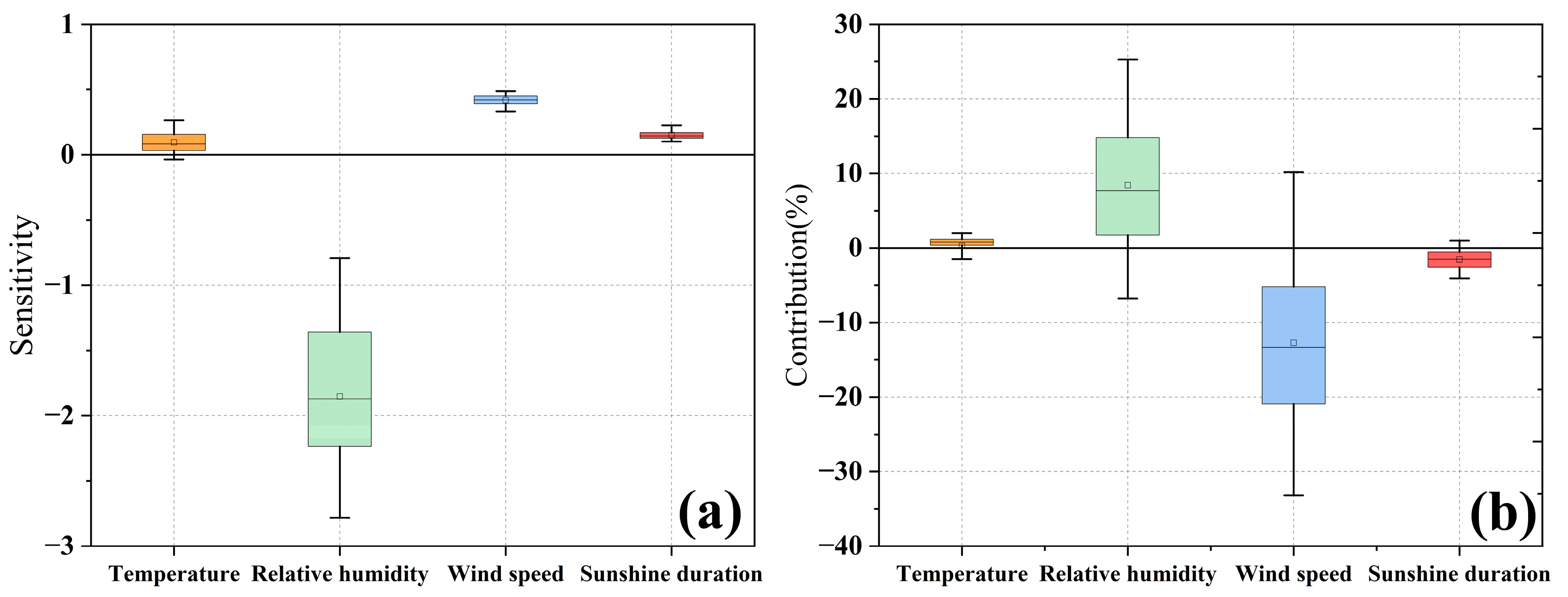
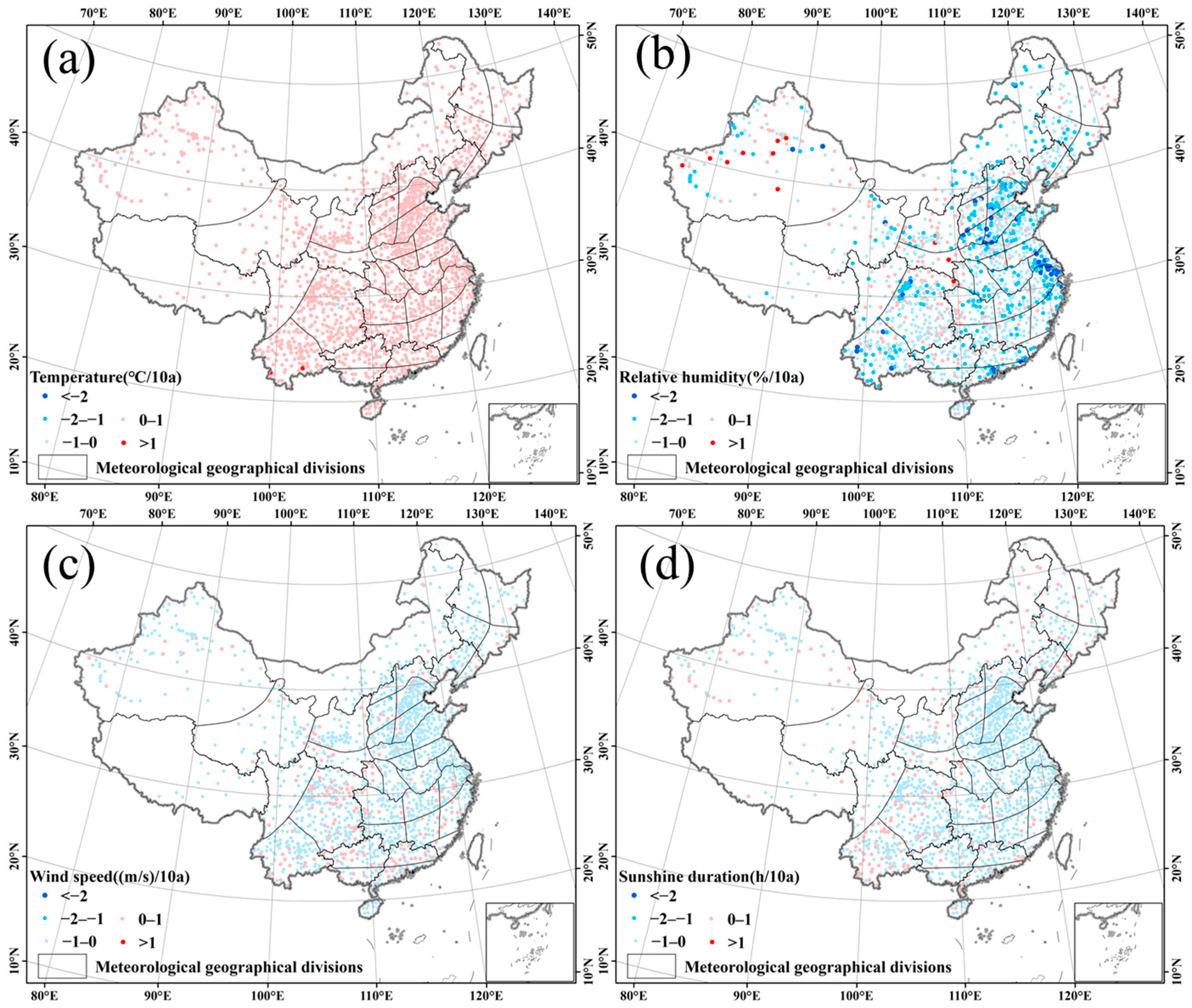

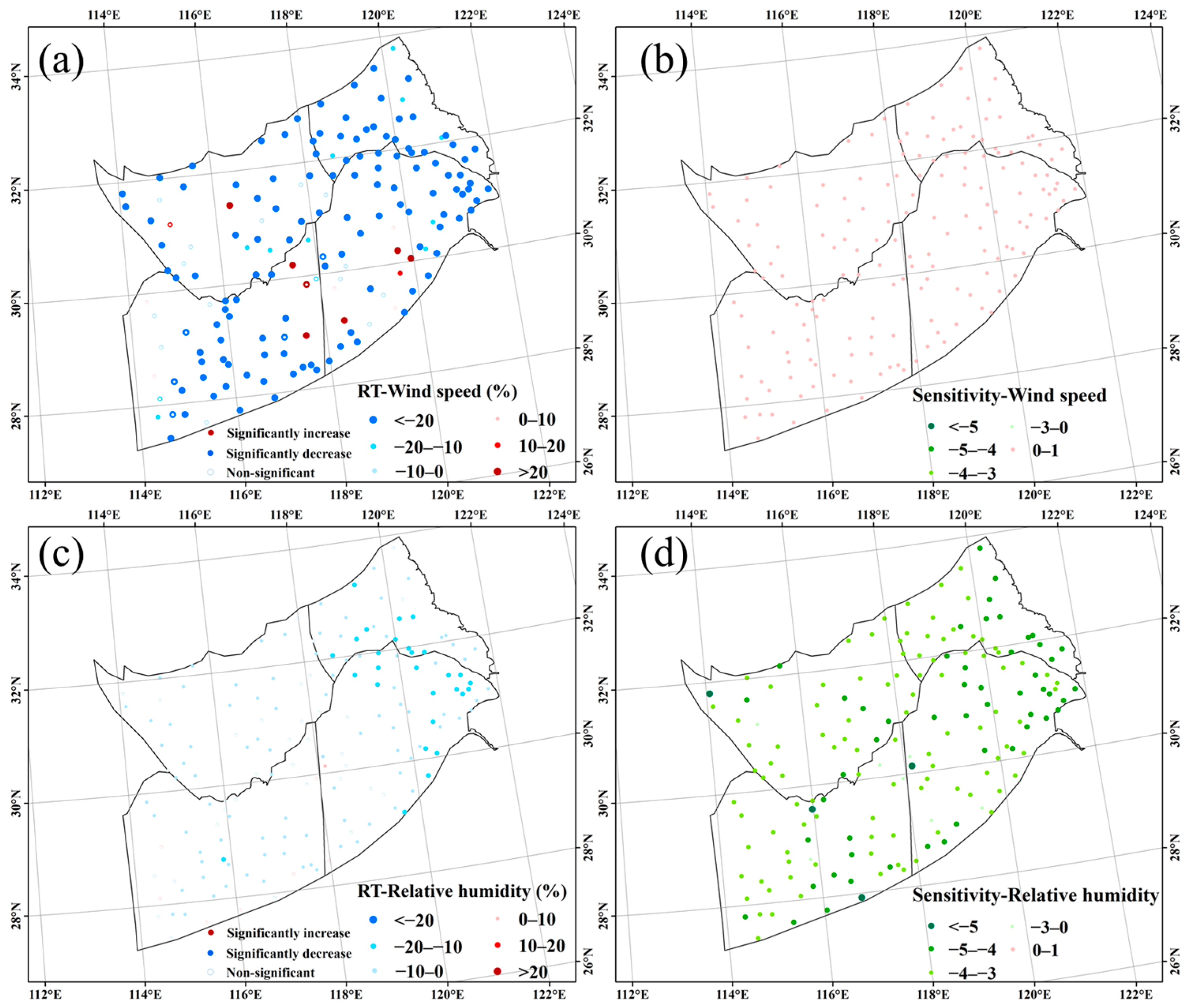
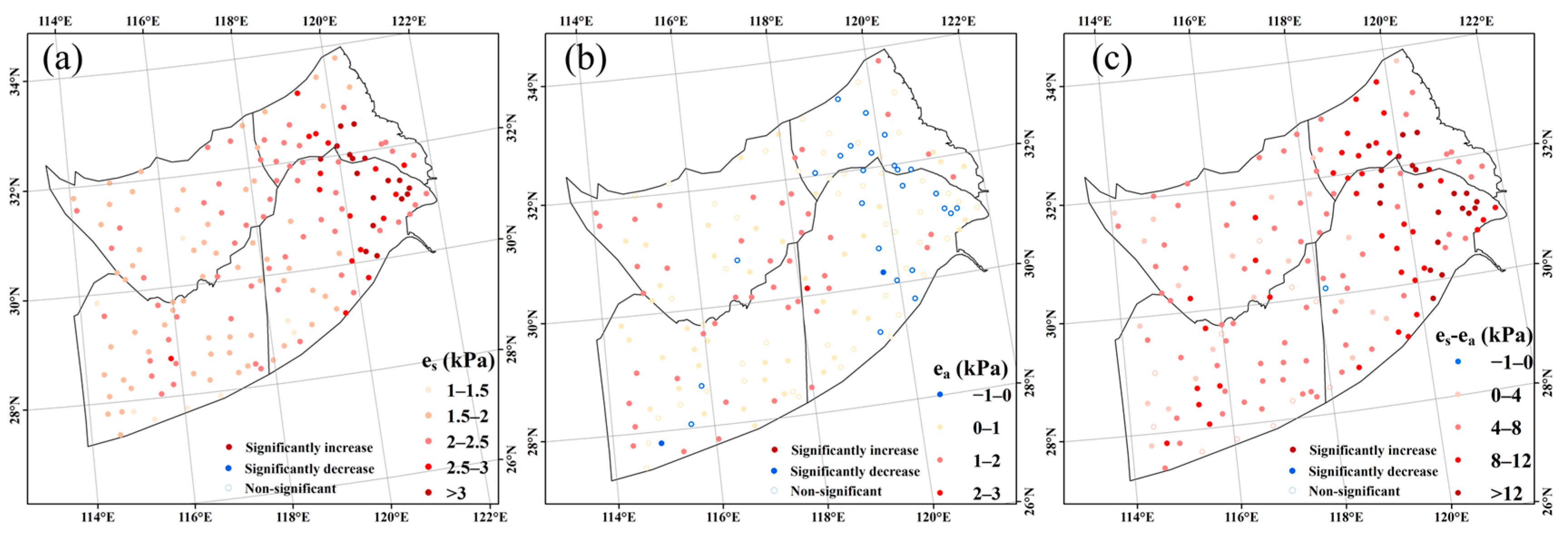
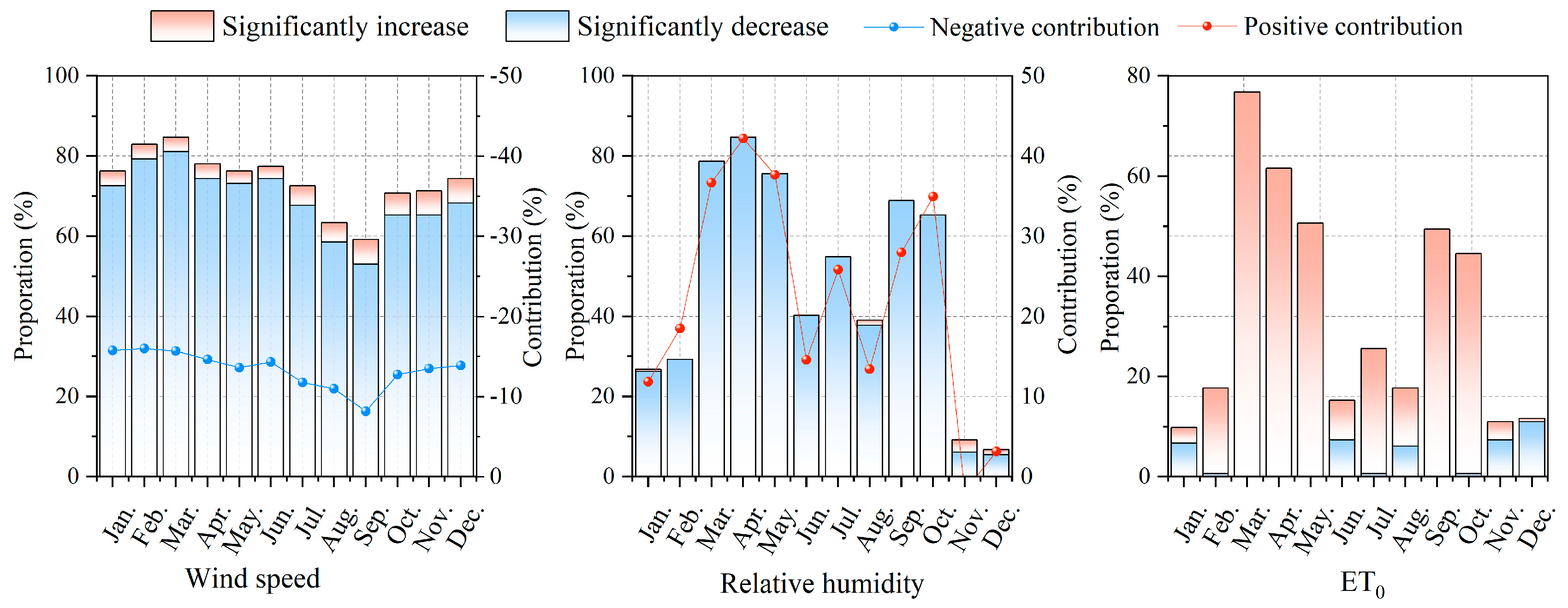
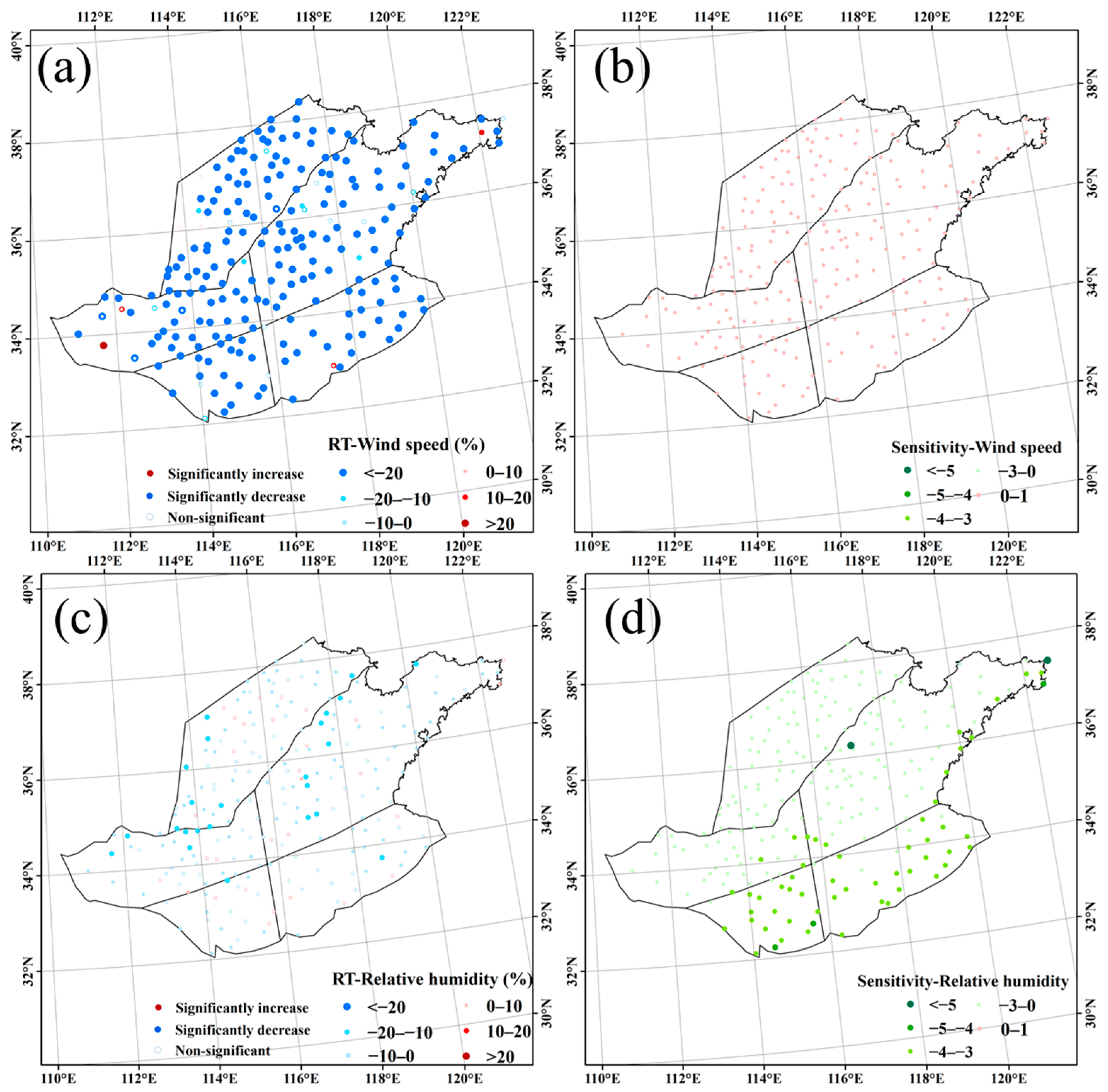
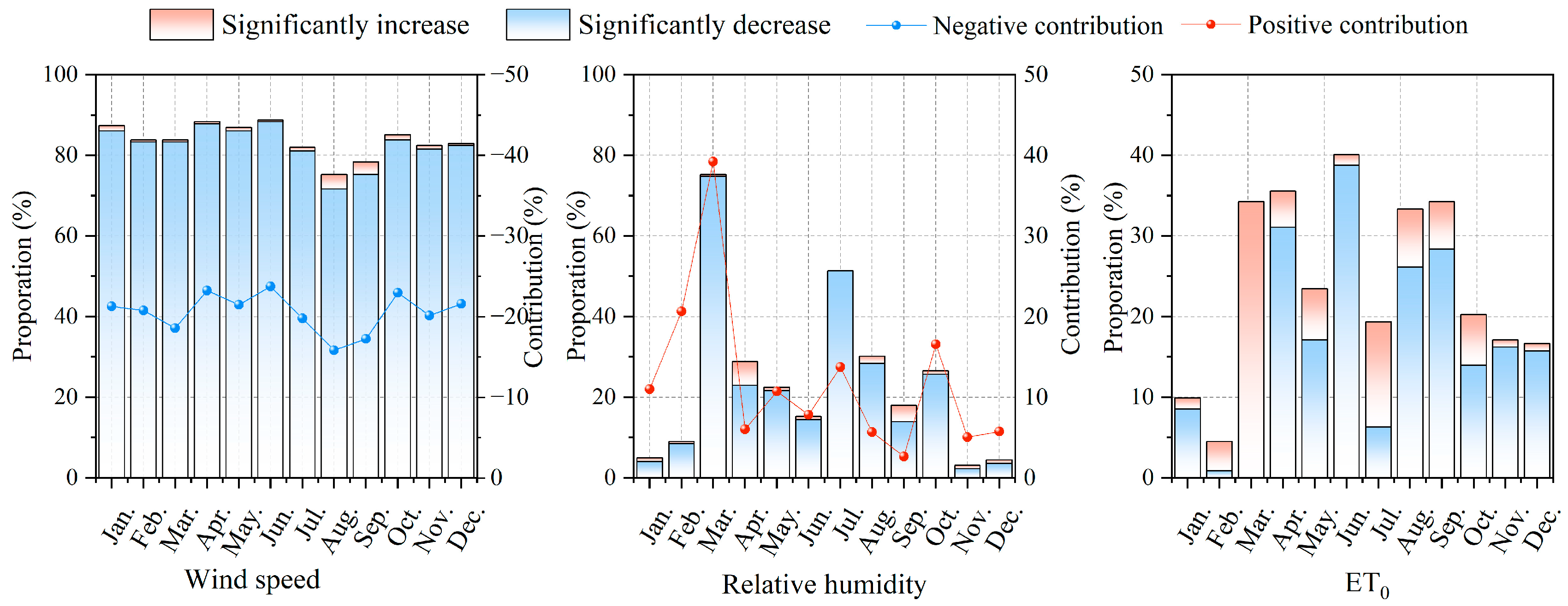
| Code | Region/Season Name | Station Numbers | Area (103 km2) |
|---|---|---|---|
| NEC | Northeast China | 130 | 785 |
| NC | North China | 232 | 432 |
| HH | Huang-Huai | 156 | 291 |
| JHA | Jianghan | 45 | 130 |
| JHU | Jiang-Huai | 62 | 138 |
| JN | Jiangnan | 260 | 655 |
| SC | South China | 170 | 525 |
| IM | Inner Mongolia | 75 | 1129 |
| NWC | Northwest China | 217 | 2920 |
| TP | Tibet Plateau | 14 | 1169 |
| SWC | Southwest China | 319 | 1112 |
| Meteorological Geographical Divisions | Meteorological Geographic Division Subregions | AI | Precipitation (mm) | ET0 (mm) | ||||||
|---|---|---|---|---|---|---|---|---|---|---|
| Up (%) | Down (%) | RT+ (%) | Up (%) | Down (%) | RT+ (%) | Up (%) | Down (%) | RT+ (%) | ||
| Northeast China | NEC1 | 23.8 * | 0.0 | 4.16 | 9.5 | 0.0 | 2.75 | 9.5 | 33.3 * | −1.72 |
| NEC2 | 50.0 * | 0.0 | 5.21 | 30.0 * | 0.0 | 2.85 | 5.0 | 45.0 * | −2.46 | |
| NEC3 | 0.0 | 0.0 | −0.55 | 0.0 | 0.0 | 0.91 | 22.2 * | 14.8 | 0.30 | |
| NEC4 | 0.0 | 6.7 | −1.30 | 0.0 | 0.0 | 0.61 | 26.7 * | 0.0 | 1.62 | |
| NEC5 | 0.0 | 6.5 | −1.91 | 0.0 | 0.0 | −1.74 | 9.7 | 3.2 | 0.31 | |
| NEC6 | 0.0 | 0.0 | −0.79 | 0.0 | 0.0 | −0.32 | 12.5 | 12.5 | 0.53 | |
| North China | NC1 | 6.7 | 0.0 | 0.73 | 6.7 | 0.0 | 2.03 | 6.7 | 20.0 * | 0.58 |
| NC2 | 4.3 | 21.7 * | −2.36 | 0.0 | 8.7 | −1.61 | 39.1 * | 13.0 | 2.27 | |
| NC3 | 0.0 | 7.4 | −2.52 | 3.7 | 0.0 | 0.43 | 40.7 * | 0.0 | 1.91 | |
| NC4 | 0.0 | 2.7 | −0.86 | 1.4 | 0.0 | −0.90 | 18.9 * | 9.5 | 0.67 | |
| NC5 | 3.8 | 7.7 | −3.45 | 0.0 | 3.8 | −2.14 | 26.9 * | 11.5 | 1.01 | |
| NC6 | 1.5 | 4.5 | 0.66 | 0.0 | 3.0 | −0.92 | 10.4 | 44.8 * | −1.41 | |
| Huang-Huai | HH1 | 16.2 | 5.4 | 1.53 | 0.0 | 0.0 | −1.15 | 13.5 | 51.4 * | −2.01 |
| HH2 | 8.3 | 2.8 | −0.03 | 0.0 | 0.0 | −0.35 | 19.4 * | 31.9 * | −0.45 | |
| HH3 | 0.0 | 5.0 | 2.51 | 0.0 | 0.0 | −0.38 | 5.0 | 50.0 * | −2.61 | |
| HH4 | 18.5 * | 3.7 | 2.48 | 0.0 | 3.7 | 0.89 | 11.1 | 33.3 * | −1.18 | |
| Jianghan | JHA1 | 0.0 | 7.7 | −1.98 | 0.0 | 0.0 | 0.12 | 30.8 * | 0.0 | 1.80 |
| JHA2 | 0.0 | 6.3 | −1.04 | 0.0 | 0.0 | 0.37 | 37.5 * | 3.1 | 1.35 | |
| Jiang-Huai | JHU1 | 0.0 | 0.0 | −2.14 | 0.0 | 0.0 | −0.85 | 29.4 * | 0.0 | 1.68 |
| JHU2 | 0.0 | 0.0 | −1.37 | 14.3 | 0.0 | 2.59 | 67.9 * | 0.0 | 4.03 | |
| Jiangnan | JN1 | 2.1 | 6.4 | −0.02 | 0.0 | 2.1 | 1.32 | 23.4 * | 6.4 | 1.39 |
| JN2 | 0.0 | 6.5 | −0.84 | 0.0 | 0.0 | 0.84 | 28.3 * | 0.0 | 1.49 | |
| JN3 | 1.8 | 9.1 | −1.07 | 34.5 * | 0.0 | 2.60 | 65.5 * | 3.6 | 4.10 | |
| JN4 | 2.9 | 2.9 | 0.17 | 2.9 | 0.0 | 1.18 | 20.0 * | 14.3 | 1.03 | |
| JN5 | 2.8 | 5.6 | −0.48 | 2.8 | 0.0 | 1.18 | 27.8 * | 11.1 | 1.50 | |
| JN6 | 2.4 | 17.1 | −1.11 | 9.8 | 0.0 | 2.36 | 58.5 * | 7.3 | 3.28 | |
| Southern China | SC1 | 6.3 | 6.3 | −0.42 | 0.0 | 0.0 | 0.95 | 37.5 * | 14.6 * | 1.13 |
| SC2 | 0.0 | 9.5 | −2.61 | 0.0 | 0.0 | −0.21 | 33.3 * | 9.5 | 1.71 | |
| SC3 | 0.0 | 35.9 * | −2.73 | 0.0 | 0.0 | 0.46 | 59.0 * | 2.6 | 3.73 | |
| SC4 | 3.7 | 20.4 * | −1.80 | 3.7 | 0.0 | −0.13 | 40.7 * | 5.6 | 2.18 | |
| SC5 | 0.0 | 25.0 * | −1.87 | 0.0 | 0.0 | 1.44 | 37.5 * | 0.0 | 2.39 | |
| Inner Mongolia | IM | 5.3 | 5.3 | −0.09 | 2.7 | 0.0 | 0.09 | 32.0 * | 16.0 * | 0.14 |
| Northwest China | NWC1 | 42.1 * | 1.1 | 6.42 | 50.5 * | 1.1 | 6.05 | 14.7 * | 37.9 * | −1.09 |
| NWC2 | 20.4 * | 6.1 | 1.00 | 30.6 * | 0.0 | 2.68 | 36.7 * | 10.2 | 0.97 | |
| NWC3 | 3.7 | 11.1 | 0.66 | 3.7 | 0.0 | 0.95 | 25.9 * | 9.3 | 1.06 | |
| NWC4 | 10.5 | 10.5 | 0.43 | 0.0 | 0.0 | 0.58 | 36.8 * | 10.5 | 0.79 | |
| Tibet Plateau | TR | 14.3 * | 0.0 | 2.71 | 14.3 | 0.0 | 1.94 | 0.0 | 21.4 * | −0.94 |
| Southwest China | SWC1 | 24.1 * | 10.3 | 1.52 | 17.2 * | 0.0 | 1.31 | 20.7 * | 37.9 * | −0.67 |
| SWC2 | 5.9 | 23.1 * | −1.61 | 0.0 | 2.7 | −0.11 | 30.6 * | 14.5 * | 1.10 | |
| SWC3 | 1.0 | 29.8 * | −3.50 | 0.0 | 5.8 | −1.93 | 34.6 * | 12.5 * | 0.86 | |
| Meteorological Geographical Divisions | Temperature | Relative Humidity | Wind Speed | Sunshine Duration | ||||
|---|---|---|---|---|---|---|---|---|
| Up (%) | Down (%) | Up (%) | Down (%) | Up (%) | Down (%) | Up (%) | Down (%) | |
| Northeast China | 98.5 * | 0.0 | 3.1 | 38.5 * | 2.3 | 81.5 * | 6.9 | 56.2 * |
| North China | 97.8 * | 0.0 | 0.9 | 56.0 * | 1.3 | 78.0 * | 0.4 | 87.1 * |
| Huang-Huai | 100.0 * | 0.0 | 1.9 | 53.8 * | 1.3 | 87.2 * | 0.0 | 91.0 * |
| Jianghan | 97.8 * | 0.0 | 2.2 | 73.3 * | 4.4 | 71.1 * | 0.0 | 66.7 * |
| Jiang-Huai | 100.0 * | 0.0 | 0.0 | 77.4 * | 1.6 | 87.1 * | 0.0 | 83.9 * |
| Jiangnan | 100.0 * | 0.0 | 1.2 | 63.1 * | 6.2 | 71.2 * | 0.4 | 62.3 * |
| Southern China | 97.1 * | 0.0 | 1.2 | 52.4 * | 14.1 * | 52.4 * | 3.5 | 48.2 * |
| Inner Mongolia area | 100.0 * | 0.0 | 0.0 | 70.7 * | 0.0 | 89.3 * | 10.7 | 50.7 * |
| Northwest China | 96.8 * | 0.0 | 11.1 * | 39.2 * | 6.0 | 67.7 * | 9.2 | 42.9 * |
| Tibet Plateau | 100.0 * | 0.0 | 0.0 | 21.4 * | 0.0 | 64.3 * | 0.0 | 42.9 * |
| Southwest China | 91.5 * | 0.6 | 4.7 | 50.5 * | 12.9 * | 58.9 * | 6.6 | 43.6 * |
Disclaimer/Publisher’s Note: The statements, opinions and data contained in all publications are solely those of the individual author(s) and contributor(s) and not of MDPI and/or the editor(s). MDPI and/or the editor(s) disclaim responsibility for any injury to people or property resulting from any ideas, methods, instructions or products referred to in the content. |
© 2023 by the authors. Licensee MDPI, Basel, Switzerland. This article is an open access article distributed under the terms and conditions of the Creative Commons Attribution (CC BY) license (https://creativecommons.org/licenses/by/4.0/).
Share and Cite
Tang, J.; Xin, Y.; Xie, Y.; Wang, W. Analysis of Dry-Wet Changes and the Driving Factors in Mainland China under Climate Change. Water 2023, 15, 2737. https://doi.org/10.3390/w15152737
Tang J, Xin Y, Xie Y, Wang W. Analysis of Dry-Wet Changes and the Driving Factors in Mainland China under Climate Change. Water. 2023; 15(15):2737. https://doi.org/10.3390/w15152737
Chicago/Turabian StyleTang, Jie, Yan Xin, Yun Xie, and Wenting Wang. 2023. "Analysis of Dry-Wet Changes and the Driving Factors in Mainland China under Climate Change" Water 15, no. 15: 2737. https://doi.org/10.3390/w15152737
APA StyleTang, J., Xin, Y., Xie, Y., & Wang, W. (2023). Analysis of Dry-Wet Changes and the Driving Factors in Mainland China under Climate Change. Water, 15(15), 2737. https://doi.org/10.3390/w15152737






